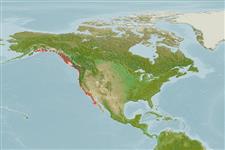Teleostei (teleosts) >
Ovalentaria/misc (Various families in series Ovalentaria) >
Embiotocidae (Surfperches)
Etymology: Brachyistius: Greek, brachys, eia = short (Ref. 45335).
More on author: Gill.
Environment: milieu / climate zone / depth range / distribution range
Ecology
Marine; demersal; depth range ? - 30 m (Ref. 2850). Subtropical; 61°N - 20°N, 154°W - 114°W
Eastern Pacific: northern British Columbia, Canada to central Baja California, Mexico, including Guadalupe Island, off north central Baja California.
Size / Weight / Age
Maturity: Lm ? range ? - ? cm
Max length : 22.0 cm TL male/unsexed; (Ref. 2850)
Found among giant kelp, usually up in kelp canopy. Feed on small crustaceans, especially ones that live on kelp. Also a cleaner which picks external parasites from other fishes. Usually occur in large aggregations in summer (Ref. 2850). Viviparous, female carries the developing young (Ref. 205).
Life cycle and mating behavior
Maturity | Reproduction | Spawning | Eggs | Fecundity | Larvae
Viviparous, female carries the developing young (Ref. 205).
Eschmeyer, W.N., E.S. Herald and H. Hammann, 1983. A field guide to Pacific coast fishes of North America. Boston (MA, USA): Houghton Mifflin Company. xii+336 p. (Ref. 2850)
IUCN Red List Status (Ref. 130435: Version 2024-1)
Threat to humans
Harmless
Human uses
Fisheries: commercial; aquarium: public aquariums
Tools
Special reports
Download XML
Internet sources
Estimates based on models
Preferred temperature (Ref.
123201): 8.4 - 18.3, mean 10.7 °C (based on 229 cells).
Phylogenetic diversity index (Ref.
82804): PD
50 = 0.7500 [Uniqueness, from 0.5 = low to 2.0 = high].
Bayesian length-weight: a=0.01318 (0.00547 - 0.03178), b=3.05 (2.84 - 3.26), in cm total length, based on LWR estimates for this (Sub)family-body shape (Ref.
93245).
Trophic level (Ref.
69278): 3.5 ±0.50 se; based on food items.
Resilience (Ref.
120179): High, minimum population doubling time less than 15 months (tm=1).
Fishing Vulnerability (Ref.
59153): Low vulnerability (12 of 100).
Nutrients (Ref.
124155): Calcium = 155 [85, 298] mg/100g; Iron = 1.43 [0.91, 2.36] mg/100g; Protein = 19.1 [18.3, 20.0] %; Omega3 = 0.368 [0.238, 0.576] g/100g; Selenium = 20.5 [11.1, 39.0] μg/100g; VitaminA = 13.1 [4.8, 35.6] μg/100g; Zinc = 0.956 [0.691, 1.351] mg/100g (wet weight);
